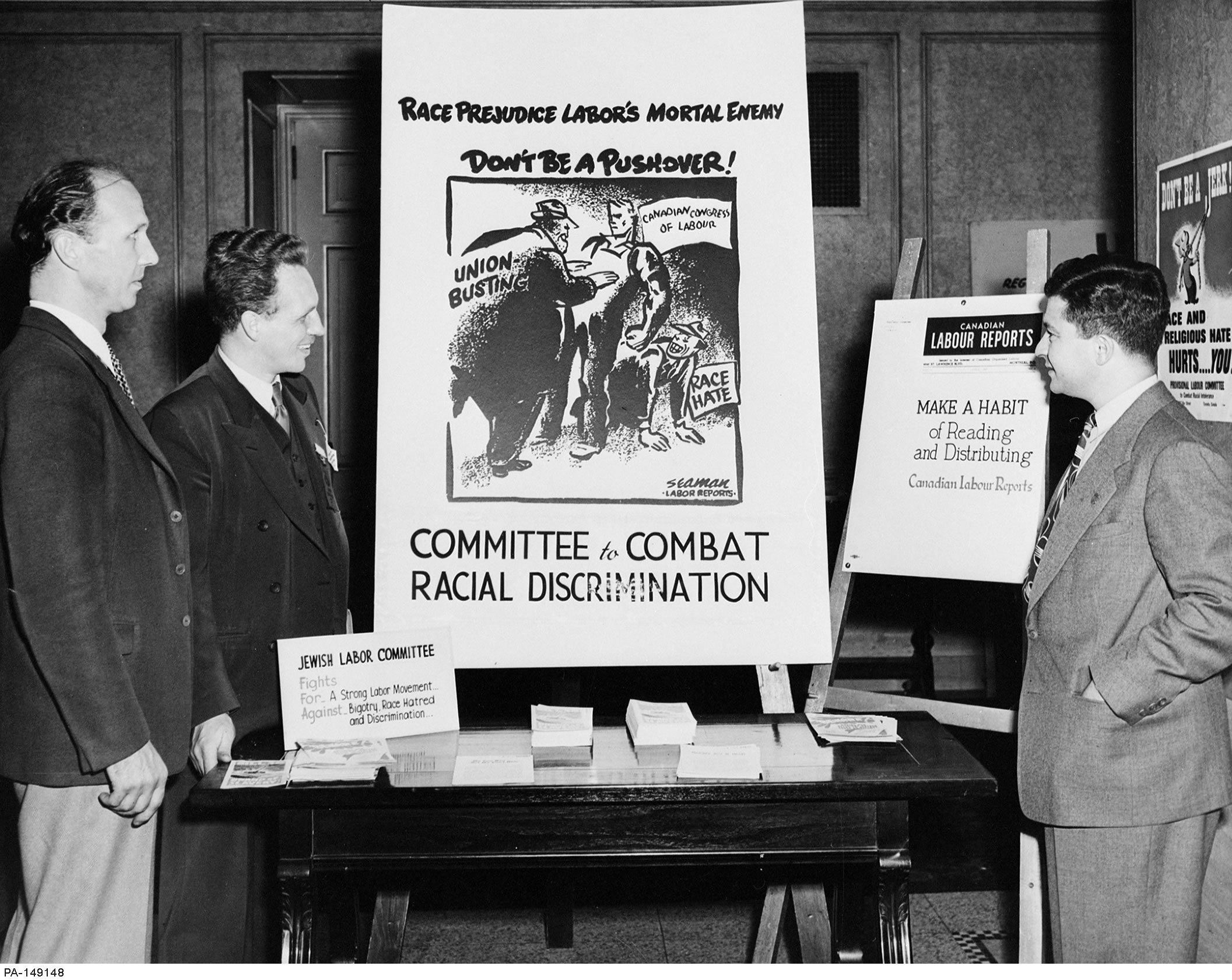Hutterites
Representing an Alberta Hutterite colony in the 1950s, lawyer Percy Davis perfectly captured the feelings of his clients when he noted that “although Canada as a nation has long since made peace with the German Reich, Alberta remains at war with its Hutterites” (quoted in Sanders, “The Hutterites”). Alberta’s first Hutterite communities were established in about 1918, and by the 1960s, more than 6,500 people lived in the province’s sixty-five colonies. Hutterites are an Anabaptist Christian sect who reject personal ownership and who own land communally; strict pacifists, they refuse to vote or hold public office. As Jonnette Watson Hamilton writes in “Space for Religion,”
“Each colony is established on a huge tract of land comprising thousands of acres, as isolated as possible from more highly populated centres … Each colony is highly coordinated and based on core Hutterite values that include co-operation, consensus, frugality, non-violence, self-discipline, and the deference of the will of the individual to the will of the community … All property within a Hutterite colony is church property; there is no distinct church organization in a colony because the community is the congregation. Professor Esau’s description of a colony is especially evocative: from the Hutterite perspective, a colony ‘may be thought of as a communal ark of salvation that leads to eternal life in heaven, while the rest of the world is drowning in the flood of temporary selfish pride and pleasure leading to death.’”
Hutterites became the target of bitter recriminations during the two world wars for refusing to serve in the Armed Forces. Ottawa removed their exemption from military service and temporarily banned their immigration. In Alberta, newspapers, school boards, politicians, and others spoke of the need to enrol Hutterite children in public schools to assist their assimilation. The provincial government appointed two committees, one in 1947 and one in 1959, to report on the “Hutterite problem.” Both committees encountered widespread hostility to Hutterites among farm, municipal, school, and community groups. Hutterites were accused of refusing to assimilate, not contributing to the economic and social life of rural communities, and controlling large tracts of Alberta farmland. Both committees sought ways to further assimilate them.
Alberta’s Land Sales Prohibition Act (1942-47) and its Communal Property Act (1947-73), both directed at Hutterites, are among the most discriminatory pieces of legislation in Canadian history. The former restricted the ability of Hutterites to buy land. The latter required that new Hutterite colonies must be at least forty miles from other colonies and that they must also acquire permission from the provincial Communal Property Control Board before they could purchase the land. The justification for this measure was ostensibly that farmers could not compete with Hutterites to buy real estate (due to the corporation tax status of Hutterites and their supposedly low standard of living). The act also aimed to prevent Hutterites from taking control of vast expanses of farmland. Directed at their communal property practices, both statutes were clearly discriminatory. But the courts turned a blind eye. The Alberta Supreme Court and the Supreme Court of Canada refused to recognize that the legislation violated Hutterites’ freedom of religion.
At odds with the spirit of Alberta’s new human rights legislation in the early 1970s, the Communal Property Act was quickly eliminated. Provincial laws no longer singled out Hutterite land acquisition. Grant Notely, the leader of the opposition New Democratic Party, described the Communal Property Act as having placed Hutterites’ “civil liberties in a state of limbo.” According to Notley, the moment had “long since passed when the Communal Property Act should be repealed – pure and simple.” [Clément 2012] A 1972 government committee rejected the previous committees’ focus on assimilation and insisted that Hutterites “contribute significantly to local and provincial economies.” [Clément 2012] The committee called for cooperation and respect. In addition, the former director of the Communal Property Control Board, who had characterized the act as a potential “instrument of discrimination,” spoke in 1971 of a “noticeable change in public attitude.” The province’s major newspapers, the Calgary Herald and the Edmonton Journal, no longer supported restrictions on Hutterites; instead, they dismissed the law as intolerant and discriminatory. Community groups stopped flooding the government with demands to assimilate Hutterites. Rather than support the legislation as a necessary tool to restrict the spread of a “foreign” people, Albertans increasingly saw it as discriminatory and as a violation of Hutterites’ rights to own property.
Further Reading
Breen, David. “The Making of Modern Alberta.” In Alberta Formed – Alberta Transformed, ed. Michael Payne, Donald Wetherell, and Catherine Cavanaugh, Vol. 2, 539-566. Calgary: University of Calgary Press, 2006.
Clément, Dominique. “Human Rights Milestones: Alberta’s Rights Revolution” In The Search for Equality and Justice: Alberta’s Human Rights Story, ed. Dominique Clément, and Renée Vaugeois, 17-57. Edmonton: John Humphrey Centre for Peace and Human Rights, 2012.
Hamilton, Jonnette Watson. “Space for Religion: Regulation of Hutterite Expansion and the Superior Court of Alberta.” In The Alberta Supreme Court at 100: History and Authority, ed. Jonathan Swainger, 159-192. Edmonton: University of Alberta Press, 2010.
Janzen, William. Limits on Liberty: The Experience of Mennonite, Hutterite, and Doukhobor Communities in Canada. Toronto: University of Toronto Press, 1990.
Sanders, Douglas E. “The Hutterites: A Case Study in Minority Rights.” Canadian Bar Review 42 (1964): 225-42.
 Site Resources
Site Resources-
- Any use of material or referencing content from HistoryOfRights.ca should be acknowledged by the User and cited as follows:
–
- Clément, Dominique. “page title or document title.” Canada’s Human Rights History. www.HistoryOfRights.ca (date accessed).


 Encyclopaedia
Encyclopaedia 
 © 2024 COPYRIGHT CLÉMENT CONSULTING. ALL RIGHTS RESERVED.
DEPARTMENT OF SOCIOLOGY, UNIVERSITY OF ALBERTA
© 2024 COPYRIGHT CLÉMENT CONSULTING. ALL RIGHTS RESERVED.
DEPARTMENT OF SOCIOLOGY, UNIVERSITY OF ALBERTA